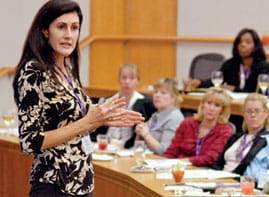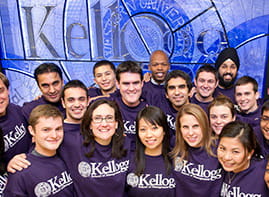Emmy and Grammy Winner teaches executives leadership lessons gleaned from decades of creative work
Untitled Document
The boardroom and the mixing board have more in common than you might think. Executives must please employees and customers. For musicians, it’s bandmates and listeners. What do the two worlds share? The need for creativity — and the fear of coming up short in front of the audience.
That’s where
Peter Himmelman and
Big Muse come in. Himmelman, an Emmy- and Grammy-winning songwriter, frontman and solo artist who’s scored such TV shows as
Judging Amy and
Bones, uses his decades of experience to help businesses amp up their creativity, idea generation and collaboration. Those years of creation and performance also made him a valuable participant in Kellogg Executive Education’s
Advanced Management Program, which brings a group of leaders with disparate backgrounds together to learn from faculty and each other.
Everyone is a performer
“Everyone is a performer,” Himmelman told us during a bit of downtime from the busy program. “Business people who think they aren’t performers are performing all the time. Creativity is the ability to absorb information in the moment, to be alive to the needs of clients and co-workers. It’s clear communication and the fearlessness to create deep innovation. Almost every great business leader is a great storyteller.”
In keeping with that, Himmelman specializes in using music and creative exercises to work with executives and employees to silence their inner critics, promote team harmony, and maintain resilience in the face of failure, among other things. And companies such as McDonalds, Pandora, Gap Inc., United Health Group and BBDO have taken the lessons to heart.
Fear of failure
Himmelman has had to overcome his own fear of failure over and over, whether it’s been in situations where he was already doing well or trying to present his ideas to a whole new audience. In the case of the former, scoring TV shows required high output in a world where time is money. “Sometimes there were 25 pieces of original music that had to be created in 48 hours,” he said. “There are people waiting. It’s a multimillion-dollar production. There’s fear there. So I figured out strategies to use the fear, repurpose it and eliminate it.”
Similarly, Himmelman had to improvise when trying to apply these strategies to helping others find creative ways to overcome fear and lack of communication. One of his most challenging and rewarding examples of that was working with the Wounded Warrior Project, an organization that supports wounded veterans and their families.
“It took me a long time to get vetted by these people,” he said. “What did this guy with a guitar have to say to our soldiers coming back with all sorts of issues? I had this whole plan, but I abandoned it when I got to meet everybody. They have PTSD and cognitive issues. I didn’t have a lot of time. My songwriting program was out of the question. They wouldn’t have been able to do that. They just needed to learn to communicate. It was an audience of people with missing hands, people who were blind, and their kids, who were sitting there with their hands folded over their chests.”
So Himmelman had each person write letters to family members detailing why they loved them, why they were important to them, why they were proud of them. All the while, he and his musicians played a backdrop of soft music to help the group along. “We went around the room. One of the older kids who’d seemed totally hopeless became like a child, crying, saying how proud he was of his dad. The colonel in charge of of the program told me it was the strongest communication they’ve seen in five years. I’ve been back many times.”
Before and after
Himmelman faces an additional challenge in the business world, where there’s no hard ROI to be demonstrated. Instead, the companies he works with measure the before-and-after difference. Executives from an IT firm in Milwaukee told him they measured the success of his program in how different their conversations were after working with him. One of Banana Republic’s chief learning officers said his employees now have a better understanding of their sense of purpose. “They’re not just selling trousers. They’re carrying out their meta-mission: exuding joy. If you help someone who’s going out on a date or headed to a job interview look good, it’s serious stuff. Steeping employees in their mission is important.”
And that, Himmelman said, is the key to how lessons in music and creativity can help those who have to run large teams. It’s communicating with themselves and others. “If you can’t self-reflect, you don’t know who you are,” he said. “If you don’t know who you are, you can’t change yourself. And if you can’t do that, you have no business leading people.”






